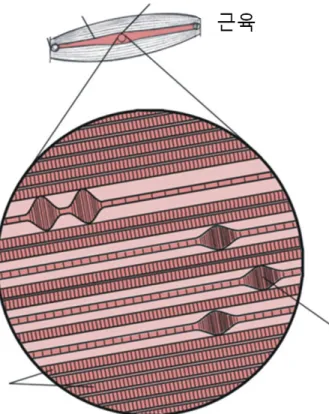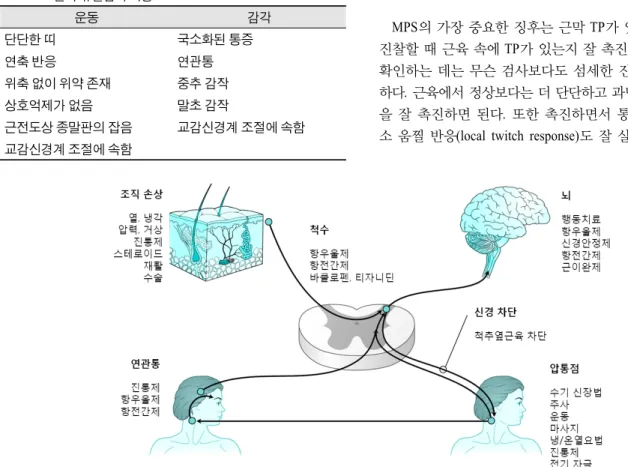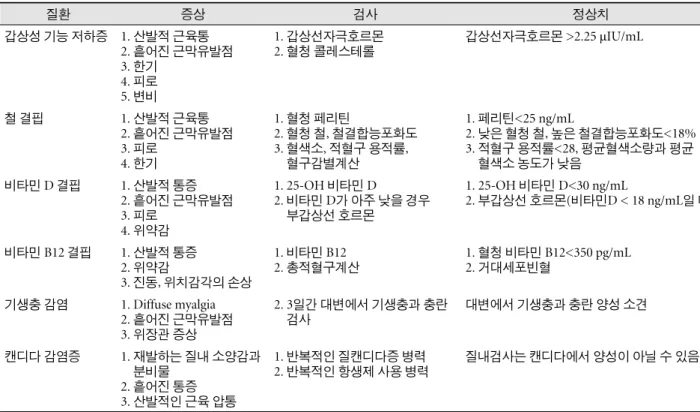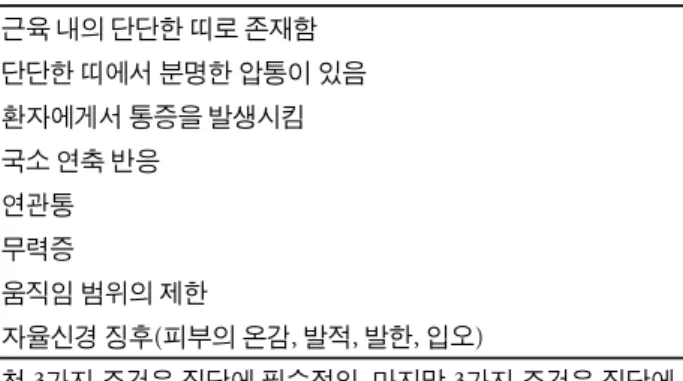Received: September 15, 2015 / Revised: October 14, 2015 / Accepted: November 22, 2015
Address for correspondence: Dong Kuck Lee, MD
Department of Neurology, Catholic University of Daegu School of Medicine, 33 Duryugongwon-ro 17-gil, Nam-gu, Daegu 42472, Korea Tel: +82-53-650-4267, Fax: +82-53-654-9786, E-mail: dklee@cu.ac.kr
유발점의 진단과 치료
대구가톨릭대학교 의과대학 신경과학교실
이 동 국
Trigger Points: Diagnosis and Treatment
Dong Kuck Lee, MD
Department of Neurology, Catholic University of Daegu School of Medicine, Daegu, Korea
ABSTRACT Trigger points are discrete, focal, hyperirritable spots located in a taut band of skeletal muscle. They produce pain locally and in a referred pattern. Patients may have regional, persistent pain resulting in a decreased range of motion in the affected muscles. Acute trauma or repetitive microtrauma may lead to the development of stress on muscle fibers and the formation of trigger points. Diagnosis of trigger point is made by clinical examination. Palpation if a hypersensitive bundle or nodule of muscle fiber is harder than normal consistency.
Palpation of the trigger point will elicit pain directly over the affected area and/or cause radiation of pain toward a zone of reference and a local twitch response. Trigger points may also manifest as tension headache, tinnitus, temporomandibular joint pain, decreased range of motion in the legs, and low back pain. Various therapeutics, such as the spray and stretch technique, ultrasonography, manipulative therapy and injection, are used to inactivate trigger points. Among them, trigger-point injection has been shown to be one of the most effective therapeutic modalities to inactivate trigger points and provide prompt relief of symptoms.
(J Pain Auton Disord 2015;4:45-50) KEYWORDS Trigger points, Diagnosis, Therapeutics
서 론
성인 중 성별을 불문하고 근골격계 만성 질환을 앓는 사 람이 아주 흔하다. 그중 대표적인 것이 근막 유발점(trigger point, TP)에 의해 발생하는 근막통증 증후군(myofascial pain syndrome, MPS)이다. 이 증후군은 다발성 압통점(tender point) 에 의해 생기는 섬유근통(fibromyalgia)과는 감별해야 한다.
이 종설에서는 만성 근골격계 통증을 일으키는 가장 흔한 원인 중 하나인 TP의 정의, 증상, 기전, 악화 및 지속인자,
진찰 , 검사, 감별진단 및 치료 등에 대해 간략하게 정리해 보고자 한다.
본 론
1. 정의TP는 골격근의 단단한 띠(taut band) 속에 있는 국소적으
로 과민한 점 (hyperirritable spot)이다. 이 점을 누르면 아프
Figure 1. Anatomy of trigger point. The trigger point is thought to be made up of a number of muscle fibers that contain focal areas of intensely contracted sarcomeres, as illustrated in this diagram.
These focal areas of small swellings are called contraction knots.
They have not been demonstrated in muscle taken from trigger points in humans, and remain theoretical, but contraction knots do fit in with the information about trigger points gained from studies in humans, including the high-frequency spontaneous electrical activity seen in trigger point electromyograms.
Figure 2. Relationsip between taut band, trigger point, and referred pain. The trigger point contains a band of hardened muscle, which may have a nodular component as well. The hardened band is known as a taut band. It extends partially or wholly between the tendinous insertions of the muscle. The region of greatest hardness is usually the zone of greatest tenderness. The notable feature of the trigger point, especially the active trigger point that is asso- ciated with the patient’s pain, is the feature of referred pain. Thus, stimulating the tender area of a taut band in the upper trapezius muscle may elicit pain in the ipsilateral temple and cause headache.
Figure 3. Anatomy of myoscial trigger point. This is a diagrammatic representation of part of a myofascial trigger point showing two motor endplates and juxtapositional contraction knots; also a neu- rovascular bundle containing motor nerves, nociceptive and sen- sory afferents and blood vessels with closely associated sympathetic fibres. Note that in a normal muscle fiber the sarcomeres are of equal length, but in a muscle fibre containing a contraction knot there is compensatory lengthening of sarcomeres on either side.
고 연관통(referred pain), 연관 압통, 운동 기능장애, 및 자율 신경 이상증상 등이 생길 수 있다. TP는 활동성(active)과 잠복성(latent)으로 나눈다. 활동성 TP는 안정 시 통증을 일 으키며 촉진하면 아프고 연관통을 일으키는 것이 특징이 다. 잠복성 TP는 자발통을 일으키지 않으나 운동 장애와 근쇠약을 일으킨다(Fig. 1-3).
1-62. 증상
TP는 국소적으로 지속적인 통증을 일으켜 운동장애를 보인다 . 자주 목, 어깨, 골반 근육 같이 자세를 유지하는 근 육을 잘 침범한다. 만약 두경부에 TP가 생기면 긴장형 두 통, 이명, 측두하악 관절통, 안구 증상 및 사경(torticollis) 등 을 보이기도 한다. 또한 TP 주변으로 연관통도 보인다. 전 체적으로 보아 TP의 증상은 크게 운동과 감각장애로 나눌
수 있다 (Table 1).
1,2,4,6,7 3. 기전MPS에서는 근육 가운데 있는 운동 종판(end plate) 부위
에 TP가 생기는 것이 특징이다. 그러나 TP의 병리기전을
아직도 자세히 모르므로 자연히 MPS의 발병기전도 아직
Figure 4. Current pathophysiologic theory of myofascial pain syndrome, including purported ac- tion sites of various treatments. Tissue injury leads to central sensitization and generation of trig- ger points.
Table 1. 근막 유발점의 특징
운동 감각
단단한 띠 국소화된 통증
연축 반응 연관통
위축 없이 위약 존재 중추 감작
상호억제가 없음 말초 감작
근전도상 종말판의 잡음 교감신경계 조절에 속함
교감신경계 조절에 속함
은 잘 모르고 있다. 그러나 현재로선 직접 또는 간접 자극 에 의해 근육 속에 TP가 발생한다고 생각하고 있다. 직접 자극으로는 과부하(overload), 나쁜 자세, 또는 동일한 자세 로 장기간 반복 작업 등으로 인한 외상이나 미세(micro) 외 상 등이 가장 널리 알려져 있다. 그 외에도 운동 부족, 비타 민 부족 , 수면 장애, 또는 관절 질환 등도 미세 외상을 일으 킨다. 또한 급성 염좌나 반복적인 스트레스 같은 급성 운 동 손상, 외과적 상처 또는 척추나 골반 수술 같이 과도한 긴장이 일어나는 조직 등에서 TP가 잘 생긴다. 어떤 원인 에 의해서도 근육이 손상을 받으면 근세포질 그물(sarco- plasmic reticulum)에서 칼슘이 분비되어 근수축을 일으키고 대사를 증가시킨다. 그 결과 serotonin, histamine, kinin 및 prostaglandin 등이 축적되어 통각수용기(nociceptor)를 자극 한 결과 중추신경계와 운동 단위에 악순환을 일으킨다. 결 국 많은 악화인자들이 운동 종판에서 acetylcholine 분비를 증가시켜 근섬유를 수축하게 만든 결과 국소 허혈과 저산 소증이 일어나며 따라서 혈관 및 신경활동물질들이 분비
되어 통증이 발생한다. Acetylcholine 분비가 계속되면 통증 과 연축(spasm)이 증가한다. 한편 직접 자극을 받지 않는 부 위에도 이차적인 TP가 생겨 원위부에 연관통(referred pain) 을 일으킨다 . 따라서 일차성 TP와 이차성 TP는 발생하는 기 전이 근본적으로 다르다 . 결국 국소 외상이나 과사용(overuse) 으로 인한 손상에 의해 일차성 TP가 생기고 그 결과 중추 감작(sensitization)에 의한 신경성(neurogenic) 표현에 의해 이 차성 TP가 생긴다고 한다(Fig. 1-4).
1-3,5,8,94. 악화 및 지속인자
TP를 지속 및 악화시키는 인자들로는 외상, 불안, 근육 쇠약 (wasting), 근육 허혈, 기후 변화, 운동신경의 신경근 압 박, 연관 내장통, 영양 결핍, 만성 감염, 내분비 및 대사 장 애, 퇴행, 기계적(mechanical) 요인, 철분 결핍 및 비타민 D 부족 등이 있다 .
3,4,85. 진찰
MPS의 가장 중요한 징후는 근막 TP가 있다는 것이므로
진찰할 때 근육 속에 TP가 있는지 잘 촉진해야 한다. TP를
확인하는 데는 무슨 검사보다도 섬세한 진찰이 가장 중요
하다. 근육에서 정상보다는 더 단단하고 과민한 결절(nodule)
을 잘 촉진하면 된다. 또한 촉진하면서 통증과 더불어 국
소 움찔 반응(local twitch response)도 잘 살펴야 하며 연관
Table 2. 유발점을 찾기 위한 절차
1. 병력과 통증 분포도: 병력을 통해 통증이 있는 부위를 알아낸다.
2. 근육 진찰을 통해 연관통을 유발할 수 있는 유발점을 찾는다.
3. 누르듯이 혹은 찌르듯이 근육을 촉지하여 근육에서 단단한 띠를 찾아낸다.
4. 단단한 띠를 촉진하면서 가장 딱딱하고 압통이 심한 부위를 찾는다(유발점).
5. 근막유발점을 누른 후 환자에게 (1) 그 부위가 아픈지 혹은 압통이 있는지, (2) 이 통증이 평소의 통증과 유사한지 질문한다.
6. 근막유발점을 5-10초간 누르면서 근막유발점에서 떨어진 부위에서도 통증이 발생하는지 질문한다(연관통).
Table 3. 근막동통증후군에서 흔히 사용되는 혈액학적 검사
질환 증상 검사 정상치
갑상성 기능 저하증 1. 산발적 근육통 2. 흩어진 근막유발점 3. 한기
4. 피로 5. 변비
1. 갑상선자극호르몬 2. 혈청 콜레스테롤
갑상선자극호르몬 >2.25 μIU/mL
철 결핍 1. 산발적 근육통
2. 흩어진 근막유발점 3. 피로
4. 한기
1. 혈청 페리틴
2. 혈청 철, 철결합능포화도 3. 혈색소, 적혈구 용적률,
혈구감별계산
1. 페리틴<25 ng/mL
2. 낮은 혈청 철, 높은 철결합능포화도<18%
3. 적혈구 용적률<28, 평균혈색소량과 평균 혈색소 농도가 낮음
비타민 D 결핍 1. 산발적 통증 2. 흩어진 근막유발점 3. 피로
4. 위약감
1. 25-OH 비타민 D
2. 비타민 D가 아주 낮을 경우 부갑상선 호르몬
1. 25-OH 비타민 D<30 ng/mL
2. 부갑상선 호르몬(비타민D < 18 ng/mL일 때)
비타민 B12 결핍 1. 산발적 통증 2. 위약감
3. 진동, 위치감각의 손상
1. 비타민 B12 2. 총적혈구계산
1. 혈청 비타민 B12<350 pg/mL 2. 거대세포빈혈
기생충 감염 1. Diffuse myalgia 2. 흩어진 근막유발점 3. 위장관 증상
2. 3일간 대변에서 기생충과 충란 검사
대변에서 기생충과 충란 양성 소견
캔디다 감염증 1. 재발하는 질내 소양감과 분비물
2. 흩어진 통증 3. 산발적인 근육 압통
1. 반복적인 질캔디다증 병력 2. 반복적인 항생제 사용 병력
질내검사는 캔디다에서 양성이 아닐 수 있음 통이 있는지도 관찰해야 한다(Table 2).
1,3,4,5,8또한 TP의 특
징적인 운동 및 감각 양상을 미리 알아 두고 TP를 진찰하 는 것이 도움이 된다(Table 1).
106. 검사
실제 TP를 진단하는 데는 진찰이 가장 중요하므로 검사 실 검사는 크게 중요하지 않다. 하지만 통증의 이차적인 원 인을 알고 감별진단하는 데는 검사실 검사가 도움이 된다.
특히 갑상선 기능 저하증, 철 결핍, 비타민 D 및 B12 부족, 기생충 감염 및 칸디다 등을 감별진단하는 데는 검사가 유 용하다. 한편 초음파도 단단한 띠를 찾고 움찔 반응을 보 는 데는 도움이 되고 MRI도 경제적으로는 비싸지만 단단
한 띠를 알아내는 데 유용하다 . 근전도검사로 TP에서 나온 다고 생각하는 종판 소음 (end plate noise)을 알 수는 있으나 경제적 문제와 촉진으로 TP를 진단하는 것보다 크게 나은 점이 없으므로 임상에서 유용하지는 않다(Table 3).
5,8-10 7. 진단TP의 세 가지 주요 특징으로는 근육 속에 단단한 띠, 단 단한 띠를 따라서 압통 , 통증 재현(reproduction) 등이 있다.
다섯 가지 부수적 특징으로는 국소 움찔 반응 , 연관통, 쇠
약, 운동 범위 감소, 자율신경이상 징후 등이 있다. 따라서
TP라고 진단하기 위해서는 세 가지 주요 특징이 있는지 잘
살펴야 한다 (Table 1, 4).
2-4,9-11Table 4. 근막유발점의 특징
근육 내의 단단한 띠로 존재함 단단한 띠에서 분명한 압통이 있음 환자에게서 통증을 발생시킴 국소 연축 반응
연관통 무력증
움직임 범위의 제한
자율신경 징후(피부의 온감, 발적, 발한, 입오)
첫 3가지 조건은 진단에 필수적임. 마지막 3가지 조건은 진단에 필요함.
Table 5. 섬유근통과 근막동통증후군의 차이
근막동통증후군 섬유근통
증상 국소적인 통증 분포 산발적인 통증 분포
발병시기 급성 발병 서서히 발병
증상 비근골격계 증상은 잘 동반되지 않음 비근골격계 증상(피로, 수면장애, 과민성 대장증후군)이 보통 존재함.
징후 통상적으로 알려진 곳에 유발점이 있음 18개의 구체적 영역 중 11개에서 연관통 없는 압통점이 있음
연축반응 유발점에서 국소연축 반응이 있음 유발점에서 국소연축 반응이 없음
장애 치료 시 장애는 거의 없음 부분적 장애가 발생할 수 있음
Table 6. 압통점과 유발점의 공통점과 차이점
유발점 압통점
성별 분포 1:1 4-9 여: 1 남
물리적 특성 근육의 단단한 띠, 연관통, 통증의 재발, 성가심 근육, 인대, 힘줄, 관절낭 내 압통점이 있음
분포 국소적, 비대칭적, 어느 근육에도 존재할 수 있음 산발적이고 대칭적임, 구체적 위치를 가짐
통증 특징 국소적 통증, 압통 전신적인 통증, 압통
피부주름 민감성 알려져 있지 않음 종종 존재함
운동성 제한적인 운동범위 과운동성
조직학적 특징 조직검사상 특이소견 없음 조직검사상 특이소견 없음
촉진 근육이 딱딱하게 만져짐(결절) 근육이 부드럽게 만져짐
통증의 측정 인접한 정상 부위보다 2 kg/cm
2의 압력역치 4 kg 압력
신뢰도 촉진과 통증측정도에 통증 반응이 좋음. 휴식 시 악화 촉진과 통증측정도에 통증 반응이 좋음
MRI 결과 자료 없음 구조적 변화는 동반하지 않음
근전도 유발점에서 1-2 mm의 자발적 유발전위 보임 근육 연축이나 탈신경 소견 없음
이질통/통각과민 유발점에만 존재함 압통점 및 다른 대조부위에도 존재함
동반이환질환 20%에서 섬유근통 동반 72%에서 유발점 가짐
MRI = magnetic resonance imaging.
8. 감별진단
MPS에서 나타나는 TP는 특히 다발성 압통점이 있는 섬
유근통과의 감별이 중요하며 각각의 증상 , 발병 시작, 징후, 움찔 반응 , 장애 등의 감별진단은 Table 5를 참고하면 된다.
또한 TP는 촉진하는 부위에만 통증이 생기는 압통점과 감 별이 중요하며 각각의 성별 분포, 진찰상 특징, 분포, 통증 양상 , 피부 과민성, 운동 장애, 조직 소견, 촉진, 통증계 (algometry) 소견, 신뢰 지수, 근전도 소견, 이질 통증(allodynia)/
통각과민(hyperalgesia), 동반 질환 등의 감별진단은 Table 6 을 참고하면 된다.
4,6,7,10,129. 치료
우선 본격적인 치료를 하기 전에 TP가 잘 생길 수 있는
선행인자와 악화인자를 교정하고 없애야 한다 . TP치료는
크게 약물치료와 비약물치료로 나눌 수 있다. 다양한 기전
을 가진 약제들이 치료에 도움이 될 수 있다(Fig. 4). 일단
Table 7. 유발점주사의 금기증
혈액학적 질환이나 항응고치료중 주사 전 3일 내 아스피린 복용력 있을 경우 국소적/혹은 전신적 감염이 있을 경우 마취제에 대한 알레르기력이 있는 경우 급성 근육 손상 상태
바늘에 대한 공포가 있는 경우
Table 8. 유발점주사의 합병증



